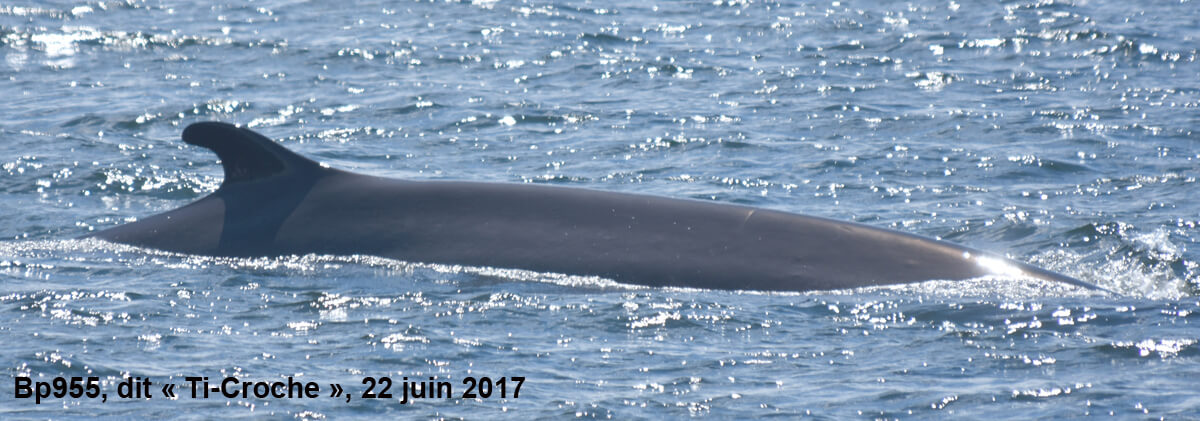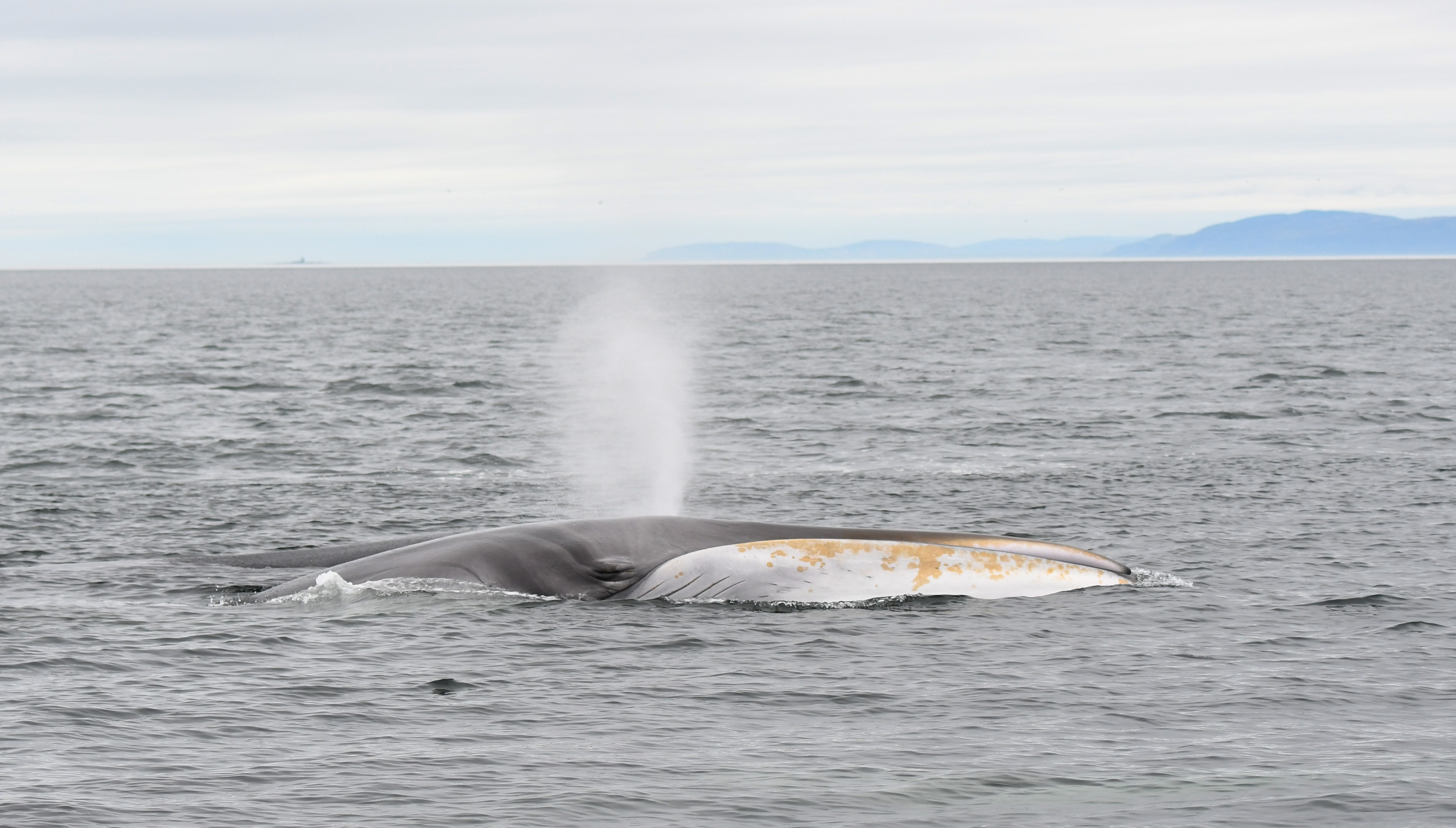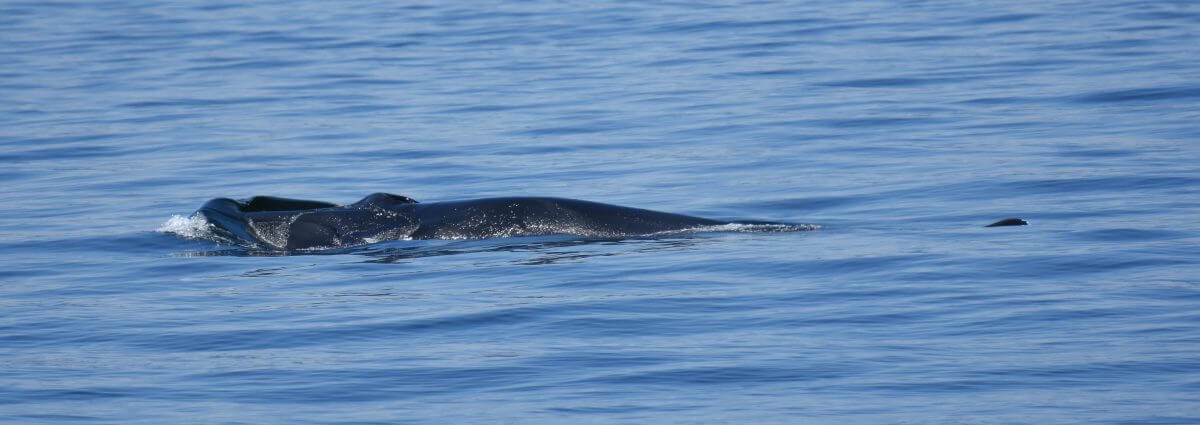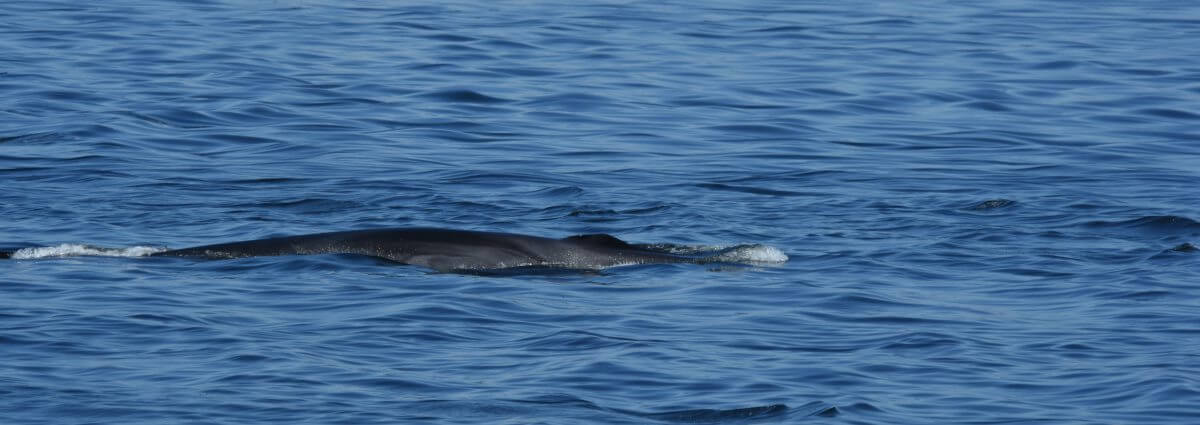Ti-Croche
Fin Whale


-
ID number
Bp955
-
Sex
Unknown
-
Year of birth
Winter 2008-2009
-
Known Since
2009
Distinctive traits
It hook-shaped dorsal fin is strongly curved toward the rear. However, it is the resemblance of Bp955’s dorsal fin with that of the late Capitaine Crochet that earned it the nickname “Ti-Croche”.
Life history
The shape of it dorsal fin reminds us of Capitaine Crochet (Bp050), whose death in 2013 represented a great loss. Thanks to a photo-ID follow-up, researchers were able to conclude in May 2018 that Capitaine Crochet is indeed the mother of Ti-Croche. A particularly clear photo of Ti-Croche taken by a GREMM collaborator on May 27, 2018 made it possible to compare it chevron to that of the calf accompanying Capitaine Crochet in a photo taken in 2009. Interestingly, Capitaine Crochet was always one of the first fin whales to arrive in the season. Ti-Croche seems to continue this trend.
In 2016, Bp955, a.k.a. Ti-Croche, had not yet reached it full adult size.
On October 5 2020, Véronique Lesage, scientific researcher at the Maurice Lamontagne Institute of Fisheries and Oceans Canada, and her team managed to tag this well known individual in the Saguenay-St. Lawrence Marine Park. And until January 13, the scientist tracked the astonishing voyage of Ti-Croche, a journey that took this individual from the Estuary to the Bahamas via Bermuda, before returning to Nova Scotia. “This is the first time we ever followed a fin whale this long in the fall and winter,” she exclaims. To read the whole story, click on this article.
Observations history in the Estuary
Years in which the animal was not observed Years in which the animal was observed
Latest news from the publications Portrait de baleines
Having not missed a single observation season since 2016, Ti-Croche continued its streak by visiting the estuary in early June! With its hook-shaped dorsal fin—reminiscent of that of its mother, the late Capitaine-Crochet—Bp955 is hard to miss. Several captains and naturalists have observed Ti-Croche swimming rather quietly since its arrival in the estuary. Should we be concerned, knowing that the fin whale is the fastest whale in the St. Lawrence, reaching speeds of up to 40 km/h when it accelerates? A few weeks ago, the GREMM research team took images of Ti-Croche by drone as part of a project to study the health of the large rorquals frequenting the estuary. Initial verdict: nothing in the animal’s condition appears abnormal. Ti-Croche may simply have been resting. Fin whales generally reach their top speed when hunting, fleeing, or traveling. How do fin whales swim so fast? The morphology of this species is very hydrodynamic: smooth skin, tapered body, and pointed rostrum. The animal’s ribs are thin and slanted backward, contributing to the sleekness of its body and its ability to swim quickly. The sickle shape of their tail fin also improves thrust—as if they were wearing flippers!
Back in the St. Lawrence Estuary in early June, Ti-Croche had just returned from quite a journey! The star fin whale spent part of the winter near Delaware, on the east coast of the United States. But how do we know? Last October, a team from Fisheries and Oceans Canada (DFO) placed a satellite transmitter at the bottom of Ti-Croche’s dorsal fin as part of a research project. Transmitting signals almost daily, these beacons are helping to unravel the mysteries of fin whale wintering grounds and migration. In 2020, Ti-Croche was also fitted with a beacon by DFO: he swam as far as the Bahamas and Bermuda. Could he have gone to breed?
We still don’t know Ti-Croche’s sex, but scientists were able to confirm in 2018, thanks to photo-identification, that he was the descendant of the famous female fin whale Capitaine Crochet! By comparing the coloration pattern on the back of a young whale that accompanied Capitaine Crochet in 2009 with recent photos of Ti-Croche, scientists were able to conclude that it was indeed the same individual. Science never ceases to amaze us!
Do you ever wonder where fin whales go when they leave the St. Lawrence Estuary? Last year, Ti-Croche, descendant of the famous Capitaine Crochet, helped improve scientists’ slim knowledge of this species’ migration and wintering grounds. Since 2014, a team from the Maurice- Lamontagne Institute led by Véronique Lesage has been tackling this question by fitting Argos-type beacons to certain individuals. By autumn 2020, nine of them, including Ti-Croche, will be so equipped. As they embark on the journey of this faithful estuary whale, researchers are surprised to discover the immensity and diversity of the fin whale’s “playground”. After feeding in the St. Lawrence Estuary, the young whale travels over 2,000 km to the Bahamas. Sexually mature (but sex undetermined), Ti-Croche may have descended to lower latitudes to reproduce. The fin whale then made a detour to Bermuda, then headed up towards the tip of Nova Scotia before its beacon stopped working on January 12, 2021. This immense 3500 km voyage was completed in just three months. So far, it’s the longest fin whale tracking in autumn-winter! We don’t know which waters Ti-Croche then explored before pointing its chevrons into the Estuary at the end of June.
Nicknamed “Ti-Croche”, Bp955 is quickly recognized by its strongly arched dorsal fin, reminiscent of a hook. In early May of this year, it was observed for the first time in the marine park. Photos taken in 2009 by collaborators Catherine Dubé and Renaud Pintiaux were compared with recent photos and confirmed the identity of this visitor by the shape of its chevron. Past rumours were well-founded: this is indeed the whale calf that accompanied the well-known Capitaine Crochet in 2009. That year, Ti-Croche was identified for the first time and observed several times alongside Capitaine Crochet during the summer, leading us to assume that it was her calf. It would now be almost 10 years old. Just as Capitaine Crochet did, before being seen for the last time in 2013 entangled in the ropes of a crab cage, Ti-Croche makes her appearances in the estuary early in the season, in late spring. Will he too become an ambassador for the Marine Park?
In fin whales, the mother-calf association rarely persists after weaning, which takes place at around 6 to 7 months of age. In the St. Lawrence Estuary, GREMM researchers sometimes observe the same calf in the company of different adults during the same season. The reason for these varied “frequentations” remains unknown. This is why, before the hypothesis of a family link between two individuals can be put forward, the calf must have been observed on the side of the same presumed female several times during the same season. This was the case for Ti-Croche, on his first visit in 2009. In the absence of sightings, a biopsy and genetic analysis can confirm beyond doubt the genetic affiliation between a calf and an adult, but this aspect has not been studied in fin whales of the St. Lawrence Estuary.
Worldwide, fin whales are most often observed alone or in small groups of 2 or 3 individuals. In the Estuary, however, some will clearly remember large groups of up to ten individuals, a phenomenon little documented elsewhere in the world. What brings fin whales together in the Estuary? For the moment, the phenomenon remains unexplained.
Last summer, an unknown fin whale made a noteworthy entrance into the Estuary. Its hook-shaped dorsal fin sparked a wave of general hope amongst captains and naturalists in the region. This particular physical attribute evoked the great disappearance of 2013: that of Capitaine Crochet (Bp050). In no time, the new visitor came to be called “Ti-Croche”, especially since this newcomer had not yet quite reached its adult size. But is Bp955 (its identification number) really the offspring of the late Capitaine Crochet?
The alleged death of the famous fin whale Capitaine Crochet had caused quite a stir both within the Marine Park’s whale-watching community as well as amongst researchers and the general public. As readers might recall, this female had been spotted emaciated and dragging a crab trap, and attempts to rescue her failed to produce the desired results; Capitaine Crochet left the Marine Park, never to return.

She owes her moniker to her dorsal fin, which was strongly arched backwards. But even if the resemblance between Capitaine Crochet’s dorsal and Bp955’s encourages quick conclusions, it is best to err on the side of caution: the shape of a fin is not a sufficient criterion for determining family relationships. For example, Bp955’s dorsal fin resembles that of another individual identified in the GREMM catalogue, Bp910.
In fact, there is only one technique that can be used to obtain reliable genetic data for identifying kinship: biopsies. A sample of a few milligrams of skin and fat is taken using a dart and then analyzed in the lab, where the DNA is extracted. Therefore, in the absence of a biopsy, we are unable to confirm (or infirm!) that Bp955 is the calf of Capitaine Crochet!






